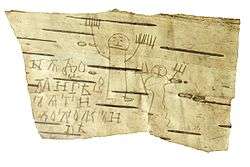Birch bark manuscript
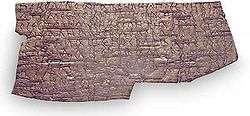
Birch bark manuscripts are documents written on pieces of the inner layer of birch bark, which was commonly used for writing before the advent of mass production of paper. Evidence of birch bark for writing goes back many centuries and in various cultures.
The oldest dated birch bark manuscripts are numerous Gandhāran Buddhist texts from approximately the 1st century CE, believed to have originated in Afghanistan, likely by the Dharmaguptaka sect. Translations of the texts, mostly in Kharoṣṭhī, have produced the earliest known versions of significant Buddhist scriptures, including a Dhammapada, discourses of Buddha that include the Rhinoceros Sutra, Avadanas and Abhidharma texts. Sanskrit birch bark manuscripts written with Brahmi script have been dated to the first few centuries CE. Several early Sanskrit writers, such as Kālidāsa (c. 4th century CE), Sushruta (c. 3rd century CE), and Varāhamihira (6th century CE) mention the use of birch bark for manuscripts. The bark of Betula utilis (Himalayan Birch) is still used today in India and Nepal for writing sacred mantras.
Russian texts discovered in Veliky Novgorod have been dated to approximately the 9th to 15th century CE. Most of those documents are letters written by various people in the Old Novgorod dialect.
Gandhāran Buddhist manuscripts
%2C_part_31_-_BL_Or._14915.jpg)
Buddhist manuscripts written in the Gāndhārī language are likely the oldest extant Indic texts, dating to approximately the 1st century CE. The birch bark texts were stored in clay jars and acquired by the British Library in 1994. They were written in Kharoṣṭhī and believed to be originally from Afghanistan due to similar birch bark manuscripts that were discovered in eastern Afghanistan.[1] Since 1994, a similar collection of Gāndhārī texts from the same era, called the Senior collection, has also surfaced.[2]
The British Library birch bark manuscripts were in the form of scrolls, which were very fragile and already damaged. They were five to nine inches wide, and consisted of twelve to eighteen inch long overlapping rolls that had been glued together to form longer scrolls. A thread sewn through the edges also helped hold them together. The script was written in black ink. The manuscripts were written on both sides of the scrolls, beginning at the top on one side, continuing with the scroll turned over and upside down, so that the text concluded at the top and back of the scroll. The longest intact scroll from the British Library collection is eighty-four inches long.[1]
The texts were likely compiled by the Dharmaguptaka sect and probably "represent a random but reasonably representative fraction of what was probably a much larger set of texts preserved in the library of a monastery of the Dharmaguptaka sect in Nagarāhāra", according to leading scholar Richard Salomon.[3] The collection includes a variety of known commentaries and sutras, including a Dhammapada, discourses of Buddha that include the Rhinoceros Sutra, avadānas and abhidharma texts.[4]
The condition of the scrolls indicates that they were already in poor condition and fragments by the time they were stored in the clay jars. Scholars concluded that the fragmented scrolls were given a ritual interment, much like Jewish texts stored in a genizah.[1]
Sanskrit and Brāhmī manuscripts
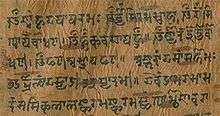
The bark of Betula utilis (Himalayan Birch) has been used for centuries in India for writing scriptures and texts in various scripts. Its use was especially prevalent in historical Kashmir. Use of bark as paper has been mentioned by early Sanskrit writers such as Kalidasa (c. 4th century CE), Sushruta (c. 3rd century CE), and Varahamihira (6th century CE). In Kashmir, early scholars recounted that all of their books were written on Himalayan Birch bark until the 16th century.[5]
A fragment of a birch bark scroll in Sanskrit, using Brāhmī script, was part of the British Library Gandhara scroll collection. It is presumed to be from North India, dating to sometime during the first few centuries CE.[6] Birch bark manuscripts in Brāhmī script were discovered in an ancient Buddhist monastery in Jaulian, near Taxila in the Punjab in Pakistan, and dated to the 5th century CE.[7]
The Bakhshali manuscript consists of seventy birch bark fragments written in Sanskrit and Prakrit, using Śāradā script. Based on the language and content, it is estimated to be from the 2nd to 3rd century CE. The text discusses various mathematical techniques.[8][9]
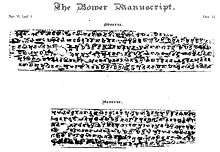
A large collection of birch bark scrolls were discovered in Afghanistan during the civil war in the late 20th and early 21st centuries, possible from the Bamiyan Caves. The approximately 3,000 scroll fragments are in Sanskrit or Buddhist Sanskrit, using Brāhmī script, and date to a period from the 2nd to 8th century CE.[6]
The Bower Manuscript is one of the oldest Sanskrit texts on birch bark using Brāhmī script. It includes several texts covering subjects including a medical treatise and proverbs. It was discovered in Kucha (currently in Aksu Prefecture in Xinjiang, China), an ancient Buddhist kingdom on the old silk road, and is estimated to be from around 450 CE.[10]
The Gilgit Manuscripts were Buddhist texts discovered in the Gilgit area of Pakistan in 1931 and include various sutras, including the Lotus Sutra, along with folk tales, medicine, and philosophy. They are dated to approximately the 5th to 6th Century AD, and were written in Buddhist Sanskrit using Śāradā script.[11][12][13]
Manuscripts containing the Devīkavaca text, a hymn praising of the Goddess Durga, were thought to protect the person who carries them from evil influences like an amulet or charm.[14] An example of one of these texts in Devanagari script from Nepal is held at Cambridge University Library (MS Add.1578).
Birch bark is still used in some parts of India and Nepal for writing sacred mantras.[5][15] This practice was first mentioned c. 8th or 9th century CE, in the Lakshmi Tantra.[16]
East Slavic texts
On July 26, 1951, during excavations in Novgorod, a Soviet expedition led by Artemiy Artsikhovsky found the first Russian birch bark writing in a layer dated to c. 1400. Since then, more than 1,000 similar documents were discovered in Staraya Russa, Smolensk, Torzhok, Pskov, Tver, Moscow, Ryazan, and Vologda,[18] although Novgorod remains by far the most prolific source of them. In Ukraine, birch bark documents were found in Zvenyhorod, Volynia. In Belarus, several documents were unearthed in Vitebsk and Mstislavl.
The late discovery of birch documents, as well as their amazing state of preservation, is explained by a deep culture layer in Novgorod (up to eight meters, or 25 feet) and heavy waterlogged clay soil which prevents the access of oxygen. Serious excavations in Novgorod started only in 1932, although some attempts had been made in the 19th century.
Although their existence was mentioned in some old East Slavic manuscripts, the discovery of birch bark documents (Russian: берестяна́я гра́мота, berestyanáya grámota, and also grámota in those documents) significantly changed the understanding of the cultural level and language spoken by the East Slavs between the 11th and 15th centuries. About a hundred styluses have also been found, mostly made of iron, some of bone or bronze.
According to Valentin Yanin and Andrey Zaliznyak, most documents are ordinary letters by various people written in what is considered to be a vernacular dialect. The letters are of a personal or business character. A few documents include elaborate obscenities. Very few documents are written in Old Church Slavonic and only one in Old Norse. The school exercises and drawings by a young boy named Onfim have drawn much attention.[19][20]
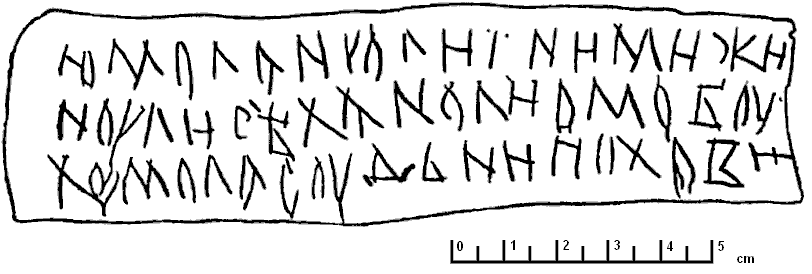
The document numbered 292 from the Novgorod excavations (unearthed in 1957) is the oldest known document in any Finnic language. It is dated to the beginning of the 13th century. The language used in the document is thought to be an archaic form of the language spoken in Olonets Karelia, a dialect of the Karelian language. For details and full text, see Birch bark letter no. 292.
Example
Novgorod birch-bark letter №366, about 1360-1380 A.D. Case of trampled wheat, release.
Original text (with added word division):
сь урѧдѣсѧ ѧковь съ гюргьмо и съ харѣтономъ по бьсудьнои грамотѣ цто былъ возѧлъ гюргѣ грамоту в ызьѣжьнои пьшьнѣцѣ а харѣтоно во проторѣхо своѣхъ и возѧ гюрьгѣ за вьсь то рубьль и трѣ грѣвоны и коробью пьшьнѣцѣ а харѣтонъ возѧ дьсѧть локотъ сукона и грѣвону а боль не надобѣ гюрьгю нѣ харѣтону до ѧкова нѣ ѧкову до гюргѧ нѣ до харитона а на то рѧдьцѣ и послусѣ давыдъ лукѣнъ сынъ и сьтьпанъ таишѣнъ
Translation (with explanations in square brackets):
Here, Yakov has settled with Gyurgiy and with Hariton by courtless deed Gyurgiy has gotten [at court] concerning trampled [by horses] wheat and Hariton concerning his loss. Gyurgiy got one rouble [money], three grivnas [money], and basket [measure] of wheat for all that, and Hariton got ten cubits of cloth and one grivna. And Gyurgiy and Hariton have no more concern to Yakov, nor Yakov to Gyurgiy and Hariton. And arrangers and perceivers to that are Davyd, son of Luka, and Stepan Taishin.
Soviet Union
There are birch bark letters written in modern times, most notably by victims of the Soviet repressions. People in Soviet forced settlements and GULAG camps in Siberia used strips of birch bark to write letters to their loved ones back home, due to inaccessibility of paper. Examples of these letters from Latvian victims of the Soviet regime are currently being considered to be included in the UNESCO "Memory of the World" heritage list.[21]
See also
- See the Old Novgorod dialect article for samples of some texts
- Onfim – boy from medieval Novgorod, famous for his birch bark drawings
- Bryggen inscriptions, documents of the same age found in Bergen, Norway
- Wiigwaasabak – birch bark scrolls of the Ojibwa people
- Palm-leaf manuscript
- Mi'kmaq hieroglyphic writing
- Russian archaeology
- List of Russian archaeologists
References
- 1 2 3 Salomon, Richard (April 1, 1997). "A preliminary survey of some early Buddhist manuscripts recently acquired by the British Library". The Journal of the American Oriental Society. American Oriental Society.
- ↑ Richard Salomon; Andrew Glass (2000). A Gāndhārī Version of the Rhinoceros Sūtra: British Library Kharoṣṭhī Fragment 5B. University of Washington Press. p. xi. ISBN 978-0-295-98035-5. Retrieved 15 July 2012.
- ↑ Richard Salomon. Ancient Buddhist Scrolls from Gandhāra: The British Library Kharosthī Fragments, with contributions by Raymond Allchin and Mark Barnard. Seattle: University of Washington Press; London: The British Library, 1999. pg 181
- ↑ Salomon, Richard (1999). Ancient Buddhist Scrolls from Gandhāra. Seattle: University of Washington Press. ISBN 0-295-97769-8.
- 1 2 Müller, Friedrich Max (1881). Selected essays on language, mythology and religion, Volume 2. Longmans, Green, and Co. pp. 335–336fn.
- 1 2 Patrick Olivelle (13 July 2006). Between the Empires: Society in India 300 Bce to 400 Ce. Oxford University Press. pp. 356–7. ISBN 978-0-19-530532-6. Retrieved 15 July 2012.
- ↑ Kurt A. Behrendt (2003). Handbuch Der Orientalistik: India. The Buddhist architecture of Gandhāra. BRILL. pp. 35–36. ISBN 978-90-04-13595-6. Retrieved 15 July 2012.
- ↑ John Newsome Crossley; Anthony Wah-Cheung Lun; Kangshen Shen; Shen Kangsheng (1999). The Nine Chapters on the Mathematical Art: Companion and Commentary. Oxford University Press. ISBN 0-19-853936-3.
- ↑ "The Bakhshali Manuscript". Treasures of the Bodleian. University of Oxford Bodleian Library. Retrieved 16 July 2012.
- ↑ David Diringer (1953). The Book Before Printing: Ancient, Medieval, and Oriental. Courier Dover Publications. p. 361. ISBN 978-0-486-24243-9. Retrieved 16 July 2012.
- ↑ Gyan Marwah. "Gilgit Manuscript — Piecing Together Fragments of History". The South Asian Magazine. Haryana, India. Retrieved 2009-06-11.
- ↑ "Gilgit Manuscript". Memory of the World Register. UNESCO. Retrieved 2009-06-11.
- ↑ "India: Rare Buddhist manuscript Lotus Sutra released". BBC News. 05-03-2012. Retrieved 17 July 2012. Check date values in:
|date=(help) - ↑ "Devīkavaca". Cambridge Digital Library. Retrieved 12 February 2013.
- ↑ Wheeler, David Martyn (2008). Hortus Revisited: A 21st Birthday Anthology. London: Frances Lincoln. p. 119. ISBN 0-7112-2738-1.
- ↑ Gupta, Sanjukta (1972). Laksmi Tantra a Pancaratra text; Orientalia Rheno-traiectina; v.15. Brill Archive. p. xxi.
- ↑ http://gramoty.ru/index.php?no=202&act=full&key=bb
- ↑ В Вологде впервые в истории города найдена берестяная грамота (in Russian). Vologda-Region. 21 July 2015. Retrieved 22 July 2015.
- ↑ Kwakkel, Erik (November 2013). "Medieval kids' doodles on birch bark". Tumblr. Retrieved 21 December 2013.
- ↑
- Schaeken, Jos (2012). Stemmen Op Berkenbast: Berichten Uit Middeleeuws Rusland: Dagelijks Leven en Communicatie. Amsterdam UP. pp. 101–105. ISBN 9789087281618.
- ↑ In Siberia Written Letters on Birch Bark
- Yanin, Valentin L. (Feb 1990). "The Archaeology of Novgorod". Scientific American, p. 84. Covers, History, "Kremlin of Novgorod", "Novgorod Museum of History", preservation dynamics, and the production of 'Birch bark documents'. This article contains examples of birch bark documents, styluses, and photographs.
External links
| Wikimedia Commons has media related to Birch bark documents. |
- British Library Gandharan Scrolls
- The Early Buddhist Manuscripts Project at University of Washington
- University of Chicago Novgorodian Scrolls
- (Russian) 956 Russian birch bark documents with modern translations
- Devīkavaca at Cambridge University Library
- Stemmen op Boombast, monograph by Jos Schaeken on the Novgorod beretsy (free download)
